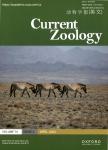Fish embryo and juvenile size under hypoxia in the mouth- brooding African cichlid Pseudocrenilabrus multicolor
Fish embryo and juvenile size under hypoxia in the mouth- brooding African cichlid Pseudocrenilabrus multicolor作者机构:Department of Biology McGill University 1205 Dr. Penfield Ave Montreal Quebec H3A 1B 1 Canada Wildlife Conservation Society 2300 Southern Boulevard Bronx NY 10460 USA
出 版 物:《Current Zoology》 (动物学报(英文版))
年 卷 期:2012年第58卷第3期
页 面:401-412页
核心收录:
学科分类:0710[理学-生物学] 083002[工学-环境工程] 0830[工学-环境科学与工程(可授工学、理学、农学学位)] 0905[农学-畜牧学] 08[工学] 0906[农学-兽医学] 09[农学] 090501[农学-动物遗传育种与繁殖]
基 金:Permission to conduct research was acquired from the Uganda National Council for Science and Technology the McGill University Animal Care Committee (Protocol #5029)
主 题:胚胎存活率 缺氧条件 育雏期 青少年 鱼类 多色 非洲 实验室实验
摘 要:We used a field survey and a laboratory rearing experiment to (a) examine response (size and survival) to life-long hypoxia in offspring of the African maternal mouth-brooding cichlid Pseudocrenilabrus multicolor victoriae (Seegers) and (b) explore the degree to which developmental response can be environmentally-induced. Embryo size metrics were quantified in 9 field populations across a range of dissolved oxygen (DO) concentrations. In the laboratory, first generation (F1) broods of low-DO origin were reared under high or low DO. Brooding period was quantified for the mothers; and egg size, egg metabolic rate and juvenile size-at-release were quantified in their (F2) offspring. The F2 offspring were split and grown for 3 months post-release under high or low DO, and juvenile size and survival were quantified. In the field survey, across stages, embryos from low-DO field populations were shorter and weighed less than embryos from high-DO populations. In the laboratory experiment, F2 eggs and juveniles-at-release from mother s mouth did not differ in mass, length, survival regardless of development DO environment. However, juveniles diverged in size after leaving mother s mouth, exhibiting smaller size when grown under low DO. Size differences in embryo size across field populations and divergence in embryo size after release from the mother s mouth support predictions for smaller body size under hypoxia. There was no evidence for negative effects on survival of juveniles after 3 months. Brooding period was 16% shorter in females reared under low DO suggesting that hypoxia may accelerate embryo development. This work provides insights into how bearer fishes respond to hypoxic stress relative to fishes with no post-spawning parental care; a shorter brooding interval and smaller body size may provide an optimal solution to parent and embryo survival under hypoxia in brooding fishes [Current Zoology 58 (3): 401-412, 2012].



